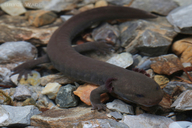|
Dicamptodon aterrimus (Cope, 1868)
Idaho Giant Salamander | family: Dicamptodontidae genus: Dicamptodon |
 © 2023 Bryce Wade (1 of 7) |
|
|
Dicamptodon aterrimus (Cope, 1867) Kirk Lohman1 1. Historical versus Current Distribution. Idaho giant salamanders (Dicamptodon aterrimus) are found in forested watersheds in north-central Idaho from the Coeur d’Alene River south to the Salmon River (Maughan et al., 1976; Nussbaum et al., 1983) and from two locations in Mineral County in extreme western Montana (Reichel and Flath, 1995). Formerly considered California giant salamanders (Dicamptodon ensatus), Idaho giant salamanders are now regarded as genetically distinct from other species in the genus (Daugherty et al., 1983; Good, 1989). Although the general outline of their range has not changed in recent years, the distribution of Idaho giant salamanders has likely been much reduced within heavily logged watersheds (Fisher, 1989; Hamilton et al., 1998; Hossack, 1998). 2. Historical versus Current Abundance. Locally abundant in headwater streams in coniferous forest watersheds. Knowledge of historical abundance is scarce, but numbers have likely been reduced in areas of intense timber harvest where larvae may be adversely affected by sedimentation and increases in water temperature (Corn and Bury, 1989a; Bury et al., 1991). 3. Life History Features. A. Breeding. Reproduction is aquatic. i. Breeding migrations. The reproductive biology of Idaho giant salamanders is presumed to be similar in most respects to that described for other members of the genus, although breeding behavior of all dicamptodontids is poorly understood. There is circumstantial evidence from population structure that breeding occurs during both spring and fall (Nussbaum, 1969; Nussbaum and Clothier, 1973). Because neoteny is common, asynchronous breeding may also be characteristic of many populations with a high proportion of neotenes (Nussbaum and Clothier, 1973). ii. Breeding habitat. Courtship likely takes places in hidden nest chambers beneath logs, stones, and crevices in small streams (Nussbaum et al., 1983). B. Eggs. i. Egg deposition sites. Nussbaum (1969a) discovered a gravid female buried 60 cm (2 ft) deep in a rock pile at the base of a small waterfall that he believed to be a nest site. Eggs are attached singly on the undersides of rocks within the nest chamber (Nussbaum, 1969a; Nussbaum et al., 1983). ii. Clutch size. Females lay 135–200 eggs (Nussbaum, 1969a; Nussbaum et al., 1983). Clutch frequency is presumed to be biennial (Nussbaum et al., 1983; Blaustein et al., 1995). Females remain with the eggs throughout development, apparently guarding them from predators (Nussbaum, 1969a). An incubation period of nearly 9 mo was reported by Henry and Twitty (1940). C. Larvae/Metamorphosis. i. Length of larval stage. Metamorphosis occurs during or after the third year (Nussbaum and Clothier, 1973). ii. Larval requirements. a. Food. Primarily benthic invertebrates and tailed frog tadpoles (Metter, 1963). Some predation on juvenile fishes by other Dicamptodon spp. has been reported (Antonelli et al., 1972; Parker, 1993a). b. Cover. Stones and submerged logs (Nussbaum et al., 1983). iii. Larval polymorphisms. None. iv. Features of metamorphosis. Transforming individuals are 92–166 mm TL (Nussbaum and Clothier, 1973). Larvae (145–150 mm TL) observed in process of metamorphosis during August in northern Idaho (K.L., personal observations). Complete metamorphosis of Idaho giant salamander larvae required from 11 d to 6 mo in aquaria (Kessel and Kessel, 1944). Mixed populations of neotenic and terrestrial adults are common (Nussbaum, 1976). v. Post-metamorphic migrations. Move from streams to moist coniferous forest floors (Nussbaum et al., 1983). vi. Neoteny. Common. D. Juvenile Habitat. Same as adults. E. Adult Habitat. Under logs and bark in coniferous forests (Nussbaum et al., 1983). Adults are rarely encountered and knowledge of their habits is scarce. F. Home Range Size. Unknown. G. Territories. Large larvae and adults are aggressive toward conspecifics, but whether larvae or adults defend territories is unknown. H. Aestivation/Avoiding Dessication. These behaviors have not been reported. I. Seasonal Migrations. Unknown. J. Torpor (Hibernation). Unknown. K. Interspecific Associations/Exclusions. Often occurs in the same streams as the tailed frog (Ascaphus truei). Tailed frog tadpoles are an important prey item for larval Idaho giant salamanders. L. Age/Size at Reproductive Maturity. Sexual maturity in both larval and terrestrial forms usually occurs at sizes greater than 115 mm SVL (Nussbaum et al., 1983). M. Longevity. Unknown. Based on a 3-yr larval period and a maximum size of 250–300 mm, a lifespan of at least 6–10 yr would not be unreasonable. N. Feeding Behavior. Larvae are sit-and-wait predators (Parker, 1994). Adult Dicamptodon feed on a wide variety of prey, including terrestrial invertebrates, small snakes, shrews, and mice (Nussbaum et al., 1983). O. Predators. Predators include fishes, garter snakes, weasels, and water shrews (Nussbaum et al., 1983; Blaustein et al., 1995). P. Anti-Predator Mechanisms. Toxic skin secretions, warning postures, and biting (Nussbaum et al., 1983). Adults are also known to growl or squawk (Nussbaum et al., 1983). Q. Diseases. Unknown. R. Parasites. Unknown. 4. Conservation. The general outline of the range of Idaho giant salamanders has not changed in recent years, and they can be locally abundant in headwater streams in coniferous forest watersheds. However, numbers have likely been reduced in areas of heavily logged watersheds where larvae may be adversely affected by sedimentation and increases in water temperature (Corn and Bury, 1989a; Fisher, 1989; Bury et al., 1991; Hamilton et al., 1998; Hossack, 1998). 1Kirk Lohman 2R. Bruce Bury Literature references for Amphibian Declines: The Conservation Status of United States Species, edited by Michael Lannoo, are here. Feedback or comments about this page.
Citation: AmphibiaWeb. 2024. <https://amphibiaweb.org> University of California, Berkeley, CA, USA. Accessed 20 Apr 2024. AmphibiaWeb's policy on data use. |




 Raffaëlli Account
Raffaëlli Account Map of Life
Map of Life